Income under section 6-5 of the ITAA97
VerifiedAdded on 2023/04/06
|11
|1612
|430
AI Summary
This document provides an overview of income under section 6-5 of the ITAA97. It explains the legislative definition of 'ordinary income' and how it applies to different types of receipts. The document discusses income from personal exertion, income from property, and income from business. It also highlights the importance of knowing if something is 'ordinary income' for tax purposes.
Contribute Materials
Your contribution can guide someone’s learning journey. Share your
documents today.
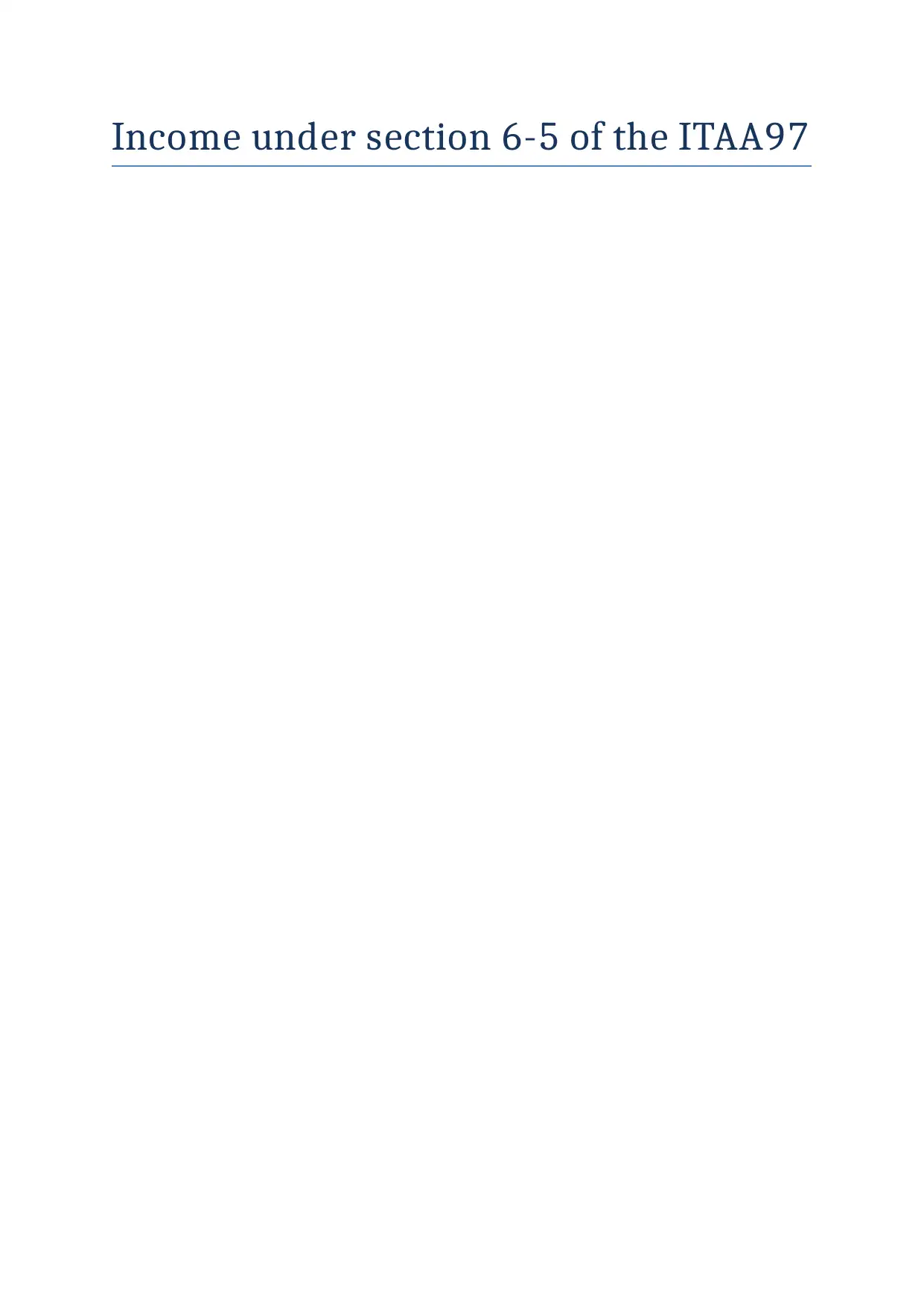
Income under section 6-5 of the ITAA97
Secure Best Marks with AI Grader
Need help grading? Try our AI Grader for instant feedback on your assignments.
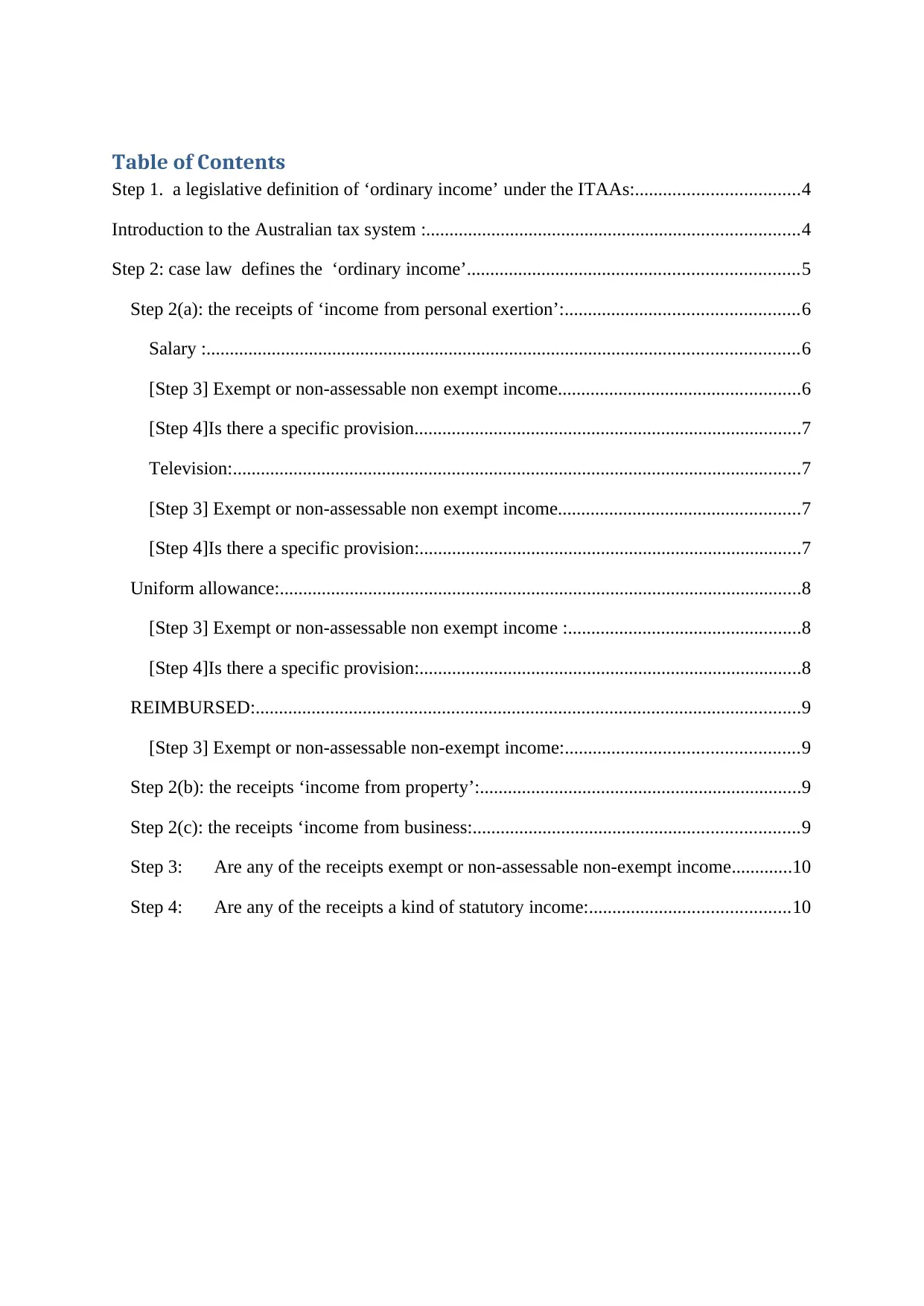
Table of Contents
Step 1. a legislative definition of ‘ordinary income’ under the ITAAs:...................................4
Introduction to the Australian tax system :................................................................................4
Step 2: case law defines the ‘ordinary income’.......................................................................5
Step 2(a): the receipts of ‘income from personal exertion’:..................................................6
Salary :...............................................................................................................................6
[Step 3] Exempt or non-assessable non exempt income....................................................6
[Step 4]Is there a specific provision...................................................................................7
Television:..........................................................................................................................7
[Step 3] Exempt or non-assessable non exempt income....................................................7
[Step 4]Is there a specific provision:..................................................................................7
Uniform allowance:................................................................................................................8
[Step 3] Exempt or non-assessable non exempt income :..................................................8
[Step 4]Is there a specific provision:..................................................................................8
REIMBURSED:.....................................................................................................................9
[Step 3] Exempt or non-assessable non-exempt income:..................................................9
Step 2(b): the receipts ‘income from property’:.....................................................................9
Step 2(c): the receipts ‘income from business:......................................................................9
Step 3: Are any of the receipts exempt or non-assessable non-exempt income.............10
Step 4: Are any of the receipts a kind of statutory income:...........................................10
Step 1. a legislative definition of ‘ordinary income’ under the ITAAs:...................................4
Introduction to the Australian tax system :................................................................................4
Step 2: case law defines the ‘ordinary income’.......................................................................5
Step 2(a): the receipts of ‘income from personal exertion’:..................................................6
Salary :...............................................................................................................................6
[Step 3] Exempt or non-assessable non exempt income....................................................6
[Step 4]Is there a specific provision...................................................................................7
Television:..........................................................................................................................7
[Step 3] Exempt or non-assessable non exempt income....................................................7
[Step 4]Is there a specific provision:..................................................................................7
Uniform allowance:................................................................................................................8
[Step 3] Exempt or non-assessable non exempt income :..................................................8
[Step 4]Is there a specific provision:..................................................................................8
REIMBURSED:.....................................................................................................................9
[Step 3] Exempt or non-assessable non-exempt income:..................................................9
Step 2(b): the receipts ‘income from property’:.....................................................................9
Step 2(c): the receipts ‘income from business:......................................................................9
Step 3: Are any of the receipts exempt or non-assessable non-exempt income.............10
Step 4: Are any of the receipts a kind of statutory income:...........................................10
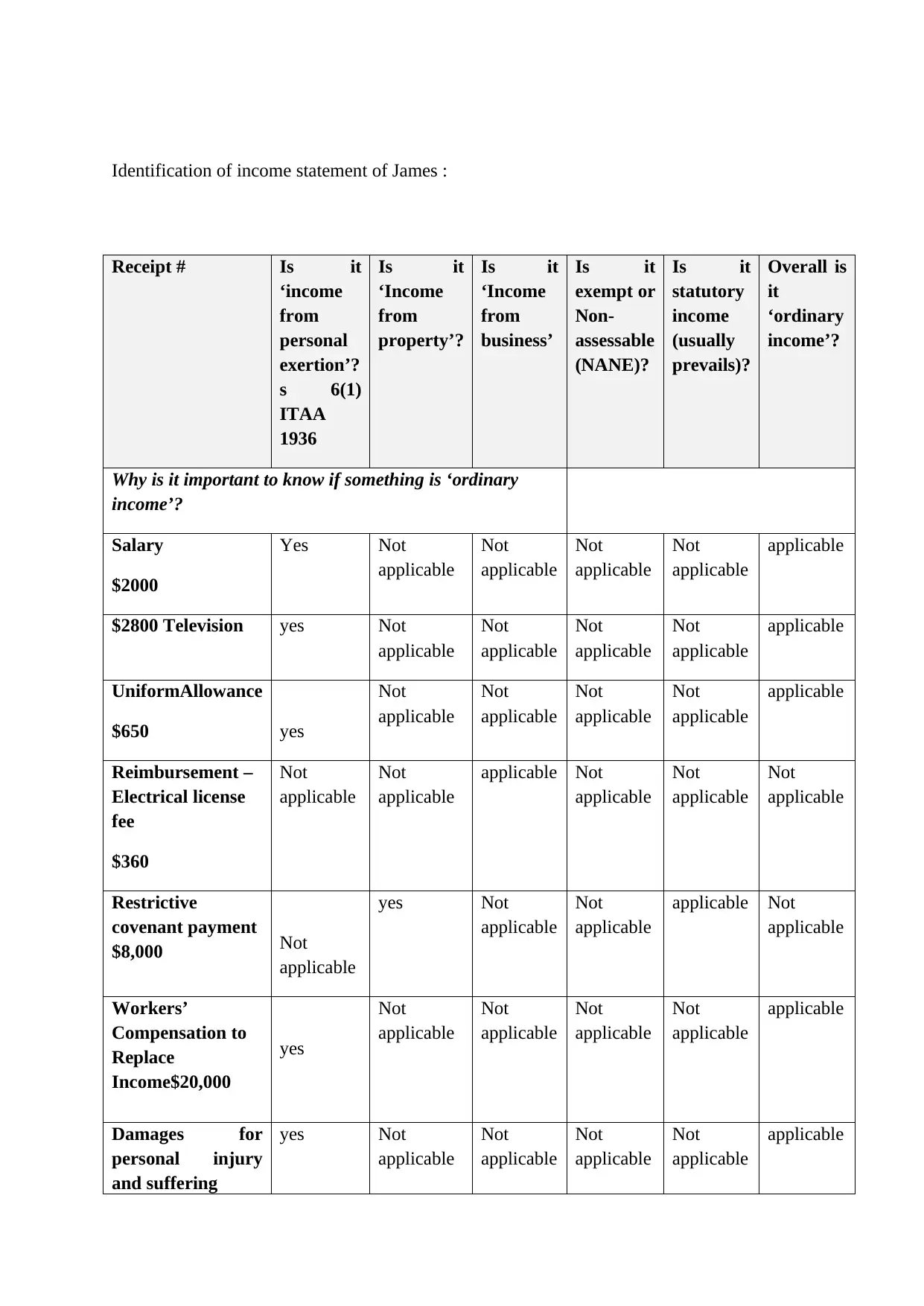
Identification of income statement of James :
Receipt # Is it
‘income
from
personal
exertion’?
s 6(1)
ITAA
1936
Is it
‘Income
from
property’?
Is it
‘Income
from
business’
Is it
exempt or
Non-
assessable
(NANE)?
Is it
statutory
income
(usually
prevails)?
Overall is
it
‘ordinary
income’?
Why is it important to know if something is ‘ordinary
income’?
Salary
$2000
Yes Not
applicable
Not
applicable
Not
applicable
Not
applicable
applicable
$2800 Television yes Not
applicable
Not
applicable
Not
applicable
Not
applicable
applicable
UniformAllowance
$650 yes
Not
applicable
Not
applicable
Not
applicable
Not
applicable
applicable
Reimbursement –
Electrical license
fee
$360
Not
applicable
Not
applicable
applicable Not
applicable
Not
applicable
Not
applicable
Restrictive
covenant payment
$8,000 Not
applicable
yes Not
applicable
Not
applicable
applicable Not
applicable
Workers’
Compensation to
Replace
Income$20,000
yes
Not
applicable
Not
applicable
Not
applicable
Not
applicable
applicable
Damages for
personal injury
and suffering
yes Not
applicable
Not
applicable
Not
applicable
Not
applicable
applicable
Receipt # Is it
‘income
from
personal
exertion’?
s 6(1)
ITAA
1936
Is it
‘Income
from
property’?
Is it
‘Income
from
business’
Is it
exempt or
Non-
assessable
(NANE)?
Is it
statutory
income
(usually
prevails)?
Overall is
it
‘ordinary
income’?
Why is it important to know if something is ‘ordinary
income’?
Salary
$2000
Yes Not
applicable
Not
applicable
Not
applicable
Not
applicable
applicable
$2800 Television yes Not
applicable
Not
applicable
Not
applicable
Not
applicable
applicable
UniformAllowance
$650 yes
Not
applicable
Not
applicable
Not
applicable
Not
applicable
applicable
Reimbursement –
Electrical license
fee
$360
Not
applicable
Not
applicable
applicable Not
applicable
Not
applicable
Not
applicable
Restrictive
covenant payment
$8,000 Not
applicable
yes Not
applicable
Not
applicable
applicable Not
applicable
Workers’
Compensation to
Replace
Income$20,000
yes
Not
applicable
Not
applicable
Not
applicable
Not
applicable
applicable
Damages for
personal injury
and suffering
yes Not
applicable
Not
applicable
Not
applicable
Not
applicable
applicable
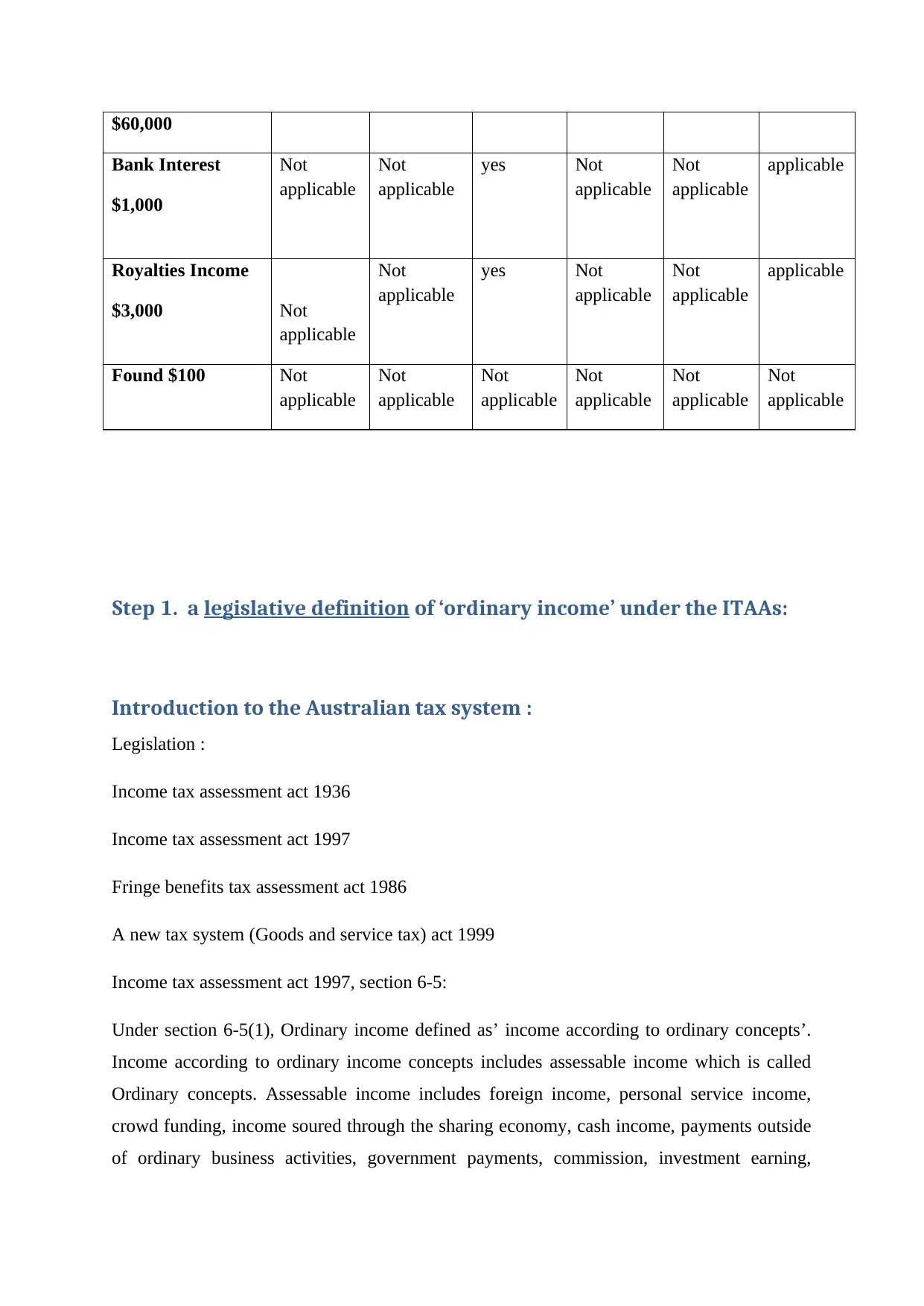
$60,000
Bank Interest
$1,000
Not
applicable
Not
applicable
yes Not
applicable
Not
applicable
applicable
Royalties Income
$3,000 Not
applicable
Not
applicable
yes Not
applicable
Not
applicable
applicable
Found $100 Not
applicable
Not
applicable
Not
applicable
Not
applicable
Not
applicable
Not
applicable
Step 1. a legislative definition of ‘ordinary income’ under the ITAAs:
Introduction to the Australian tax system :
Legislation :
Income tax assessment act 1936
Income tax assessment act 1997
Fringe benefits tax assessment act 1986
A new tax system (Goods and service tax) act 1999
Income tax assessment act 1997, section 6-5:
Under section 6-5(1), Ordinary income defined as’ income according to ordinary concepts’.
Income according to ordinary income concepts includes assessable income which is called
Ordinary concepts. Assessable income includes foreign income, personal service income,
crowd funding, income soured through the sharing economy, cash income, payments outside
of ordinary business activities, government payments, commission, investment earning,
Bank Interest
$1,000
Not
applicable
Not
applicable
yes Not
applicable
Not
applicable
applicable
Royalties Income
$3,000 Not
applicable
Not
applicable
yes Not
applicable
Not
applicable
applicable
Found $100 Not
applicable
Not
applicable
Not
applicable
Not
applicable
Not
applicable
Not
applicable
Step 1. a legislative definition of ‘ordinary income’ under the ITAAs:
Introduction to the Australian tax system :
Legislation :
Income tax assessment act 1936
Income tax assessment act 1997
Fringe benefits tax assessment act 1986
A new tax system (Goods and service tax) act 1999
Income tax assessment act 1997, section 6-5:
Under section 6-5(1), Ordinary income defined as’ income according to ordinary concepts’.
Income according to ordinary income concepts includes assessable income which is called
Ordinary concepts. Assessable income includes foreign income, personal service income,
crowd funding, income soured through the sharing economy, cash income, payments outside
of ordinary business activities, government payments, commission, investment earning,
Secure Best Marks with AI Grader
Need help grading? Try our AI Grader for instant feedback on your assignments.
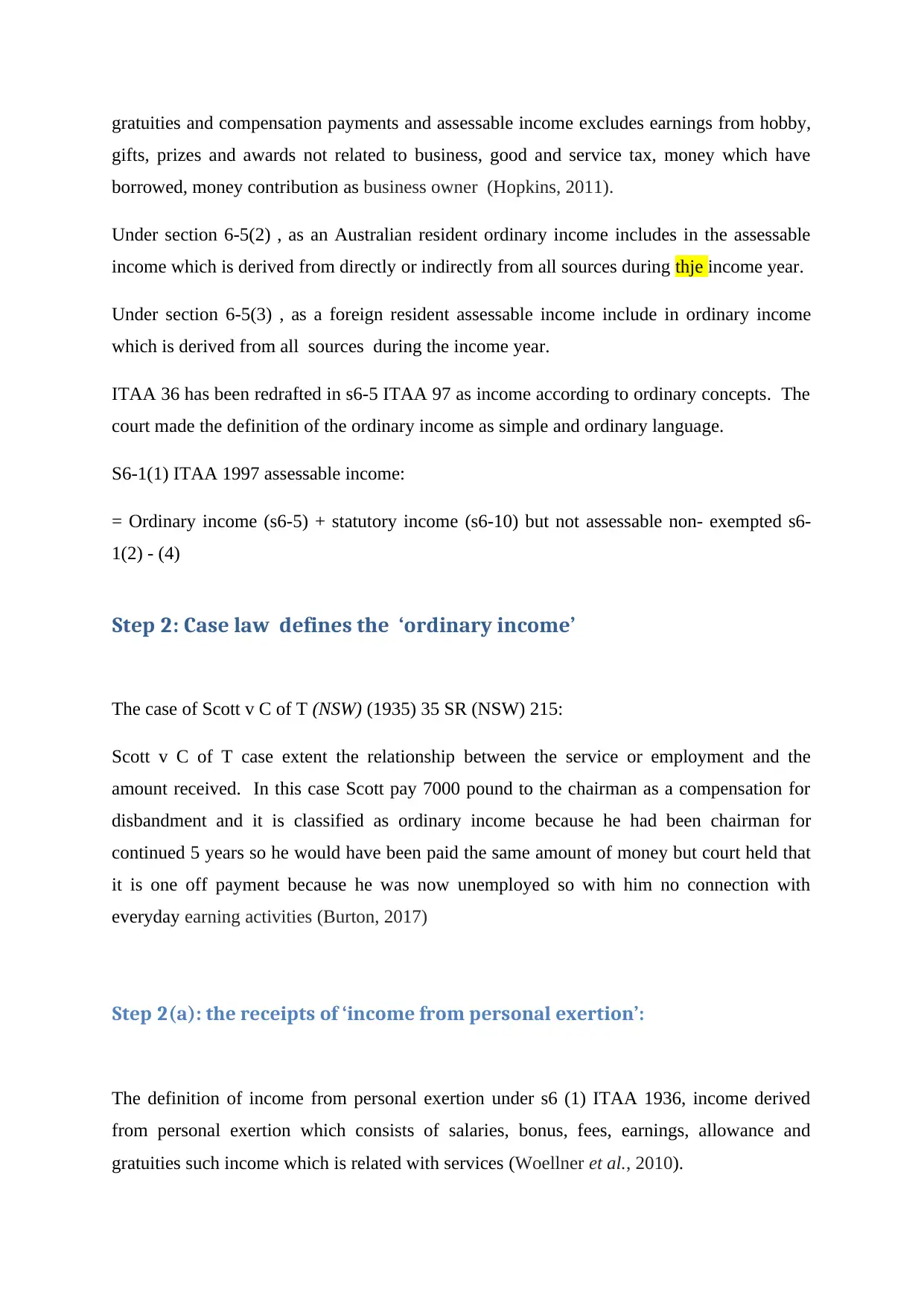
gratuities and compensation payments and assessable income excludes earnings from hobby,
gifts, prizes and awards not related to business, good and service tax, money which have
borrowed, money contribution as business owner (Hopkins, 2011).
Under section 6-5(2) , as an Australian resident ordinary income includes in the assessable
income which is derived from directly or indirectly from all sources during thje income year.
Under section 6-5(3) , as a foreign resident assessable income include in ordinary income
which is derived from all sources during the income year.
ITAA 36 has been redrafted in s6-5 ITAA 97 as income according to ordinary concepts. The
court made the definition of the ordinary income as simple and ordinary language.
S6-1(1) ITAA 1997 assessable income:
= Ordinary income (s6-5) + statutory income (s6-10) but not assessable non- exempted s6-
1(2) - (4)
Step 2: Case law defines the ‘ordinary income’
The case of Scott v C of T (NSW) (1935) 35 SR (NSW) 215:
Scott v C of T case extent the relationship between the service or employment and the
amount received. In this case Scott pay 7000 pound to the chairman as a compensation for
disbandment and it is classified as ordinary income because he had been chairman for
continued 5 years so he would have been paid the same amount of money but court held that
it is one off payment because he was now unemployed so with him no connection with
everyday earning activities (Burton, 2017)
Step 2(a): the receipts of ‘income from personal exertion’:
The definition of income from personal exertion under s6 (1) ITAA 1936, income derived
from personal exertion which consists of salaries, bonus, fees, earnings, allowance and
gratuities such income which is related with services (Woellner et al., 2010).
gifts, prizes and awards not related to business, good and service tax, money which have
borrowed, money contribution as business owner (Hopkins, 2011).
Under section 6-5(2) , as an Australian resident ordinary income includes in the assessable
income which is derived from directly or indirectly from all sources during thje income year.
Under section 6-5(3) , as a foreign resident assessable income include in ordinary income
which is derived from all sources during the income year.
ITAA 36 has been redrafted in s6-5 ITAA 97 as income according to ordinary concepts. The
court made the definition of the ordinary income as simple and ordinary language.
S6-1(1) ITAA 1997 assessable income:
= Ordinary income (s6-5) + statutory income (s6-10) but not assessable non- exempted s6-
1(2) - (4)
Step 2: Case law defines the ‘ordinary income’
The case of Scott v C of T (NSW) (1935) 35 SR (NSW) 215:
Scott v C of T case extent the relationship between the service or employment and the
amount received. In this case Scott pay 7000 pound to the chairman as a compensation for
disbandment and it is classified as ordinary income because he had been chairman for
continued 5 years so he would have been paid the same amount of money but court held that
it is one off payment because he was now unemployed so with him no connection with
everyday earning activities (Burton, 2017)
Step 2(a): the receipts of ‘income from personal exertion’:
The definition of income from personal exertion under s6 (1) ITAA 1936, income derived
from personal exertion which consists of salaries, bonus, fees, earnings, allowance and
gratuities such income which is related with services (Woellner et al., 2010).
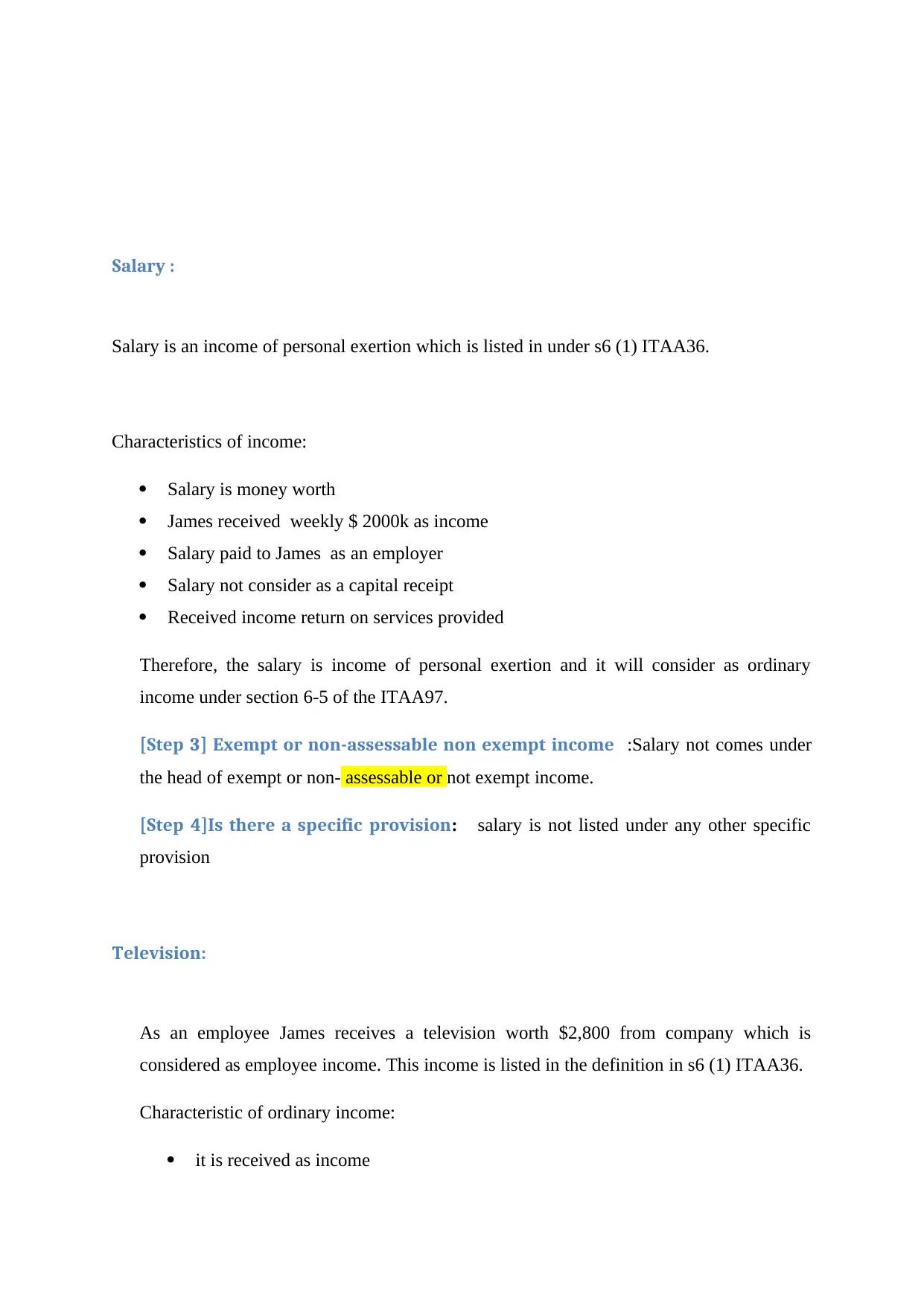
Salary :
Salary is an income of personal exertion which is listed in under s6 (1) ITAA36.
Characteristics of income:
Salary is money worth
James received weekly $ 2000k as income
Salary paid to James as an employer
Salary not consider as a capital receipt
Received income return on services provided
Therefore, the salary is income of personal exertion and it will consider as ordinary
income under section 6-5 of the ITAA97.
[Step 3] Exempt or non-assessable non exempt income :Salary not comes under
the head of exempt or non- assessable or not exempt income.
[Step 4]Is there a specific provision: salary is not listed under any other specific
provision
Television:
As an employee James receives a television worth $2,800 from company which is
considered as employee income. This income is listed in the definition in s6 (1) ITAA36.
Characteristic of ordinary income:
it is received as income
Salary is an income of personal exertion which is listed in under s6 (1) ITAA36.
Characteristics of income:
Salary is money worth
James received weekly $ 2000k as income
Salary paid to James as an employer
Salary not consider as a capital receipt
Received income return on services provided
Therefore, the salary is income of personal exertion and it will consider as ordinary
income under section 6-5 of the ITAA97.
[Step 3] Exempt or non-assessable non exempt income :Salary not comes under
the head of exempt or non- assessable or not exempt income.
[Step 4]Is there a specific provision: salary is not listed under any other specific
provision
Television:
As an employee James receives a television worth $2,800 from company which is
considered as employee income. This income is listed in the definition in s6 (1) ITAA36.
Characteristic of ordinary income:
it is received as income
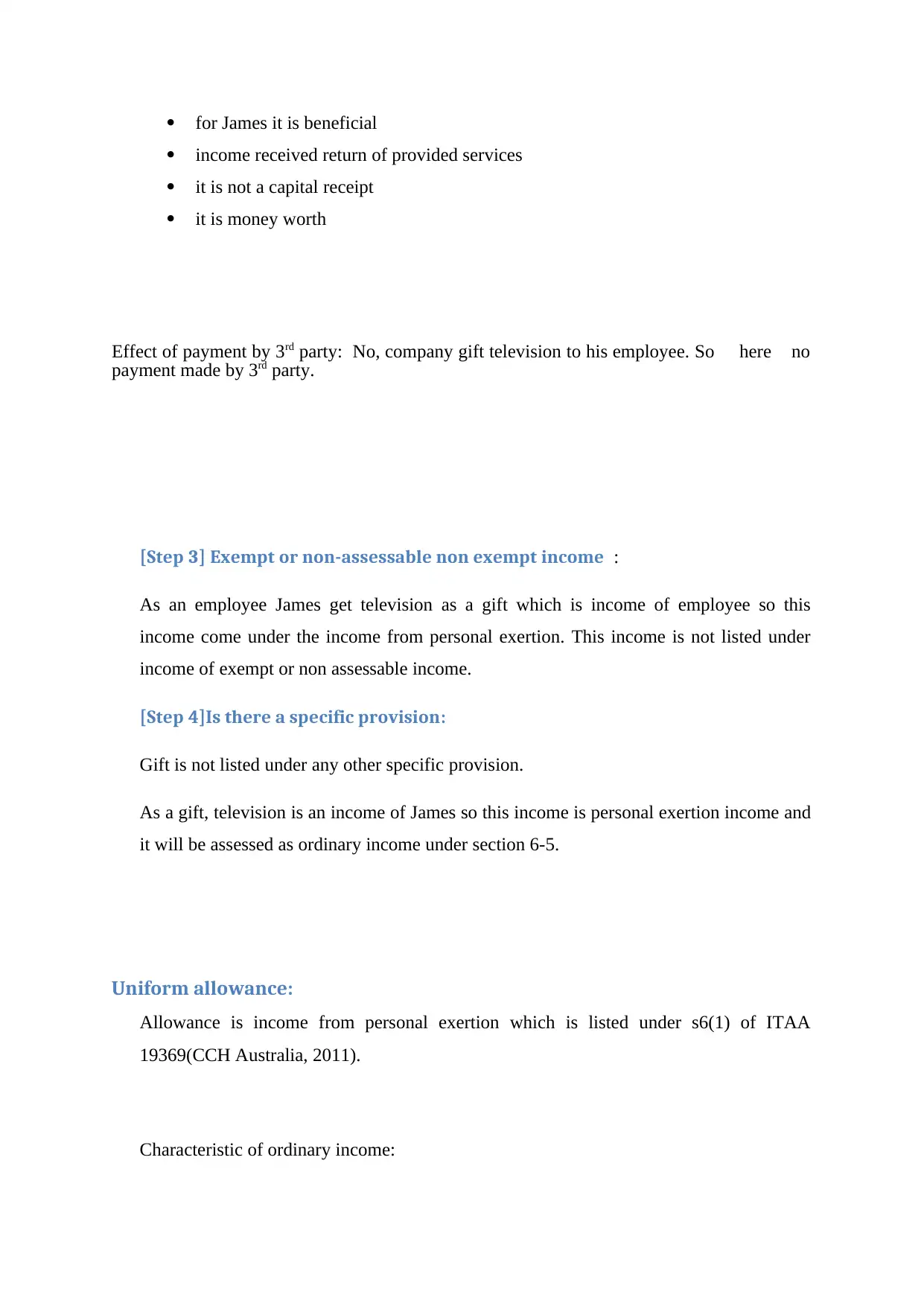
for James it is beneficial
income received return of provided services
it is not a capital receipt
it is money worth
Effect of payment by 3rd party: No, company gift television to his employee. So here no
payment made by 3rd party.
[Step 3] Exempt or non-assessable non exempt income :
As an employee James get television as a gift which is income of employee so this
income come under the income from personal exertion. This income is not listed under
income of exempt or non assessable income.
[Step 4]Is there a specific provision:
Gift is not listed under any other specific provision.
As a gift, television is an income of James so this income is personal exertion income and
it will be assessed as ordinary income under section 6-5.
Uniform allowance:
Allowance is income from personal exertion which is listed under s6(1) of ITAA
19369(CCH Australia, 2011).
Characteristic of ordinary income:
income received return of provided services
it is not a capital receipt
it is money worth
Effect of payment by 3rd party: No, company gift television to his employee. So here no
payment made by 3rd party.
[Step 3] Exempt or non-assessable non exempt income :
As an employee James get television as a gift which is income of employee so this
income come under the income from personal exertion. This income is not listed under
income of exempt or non assessable income.
[Step 4]Is there a specific provision:
Gift is not listed under any other specific provision.
As a gift, television is an income of James so this income is personal exertion income and
it will be assessed as ordinary income under section 6-5.
Uniform allowance:
Allowance is income from personal exertion which is listed under s6(1) of ITAA
19369(CCH Australia, 2011).
Characteristic of ordinary income:
Paraphrase This Document
Need a fresh take? Get an instant paraphrase of this document with our AI Paraphraser
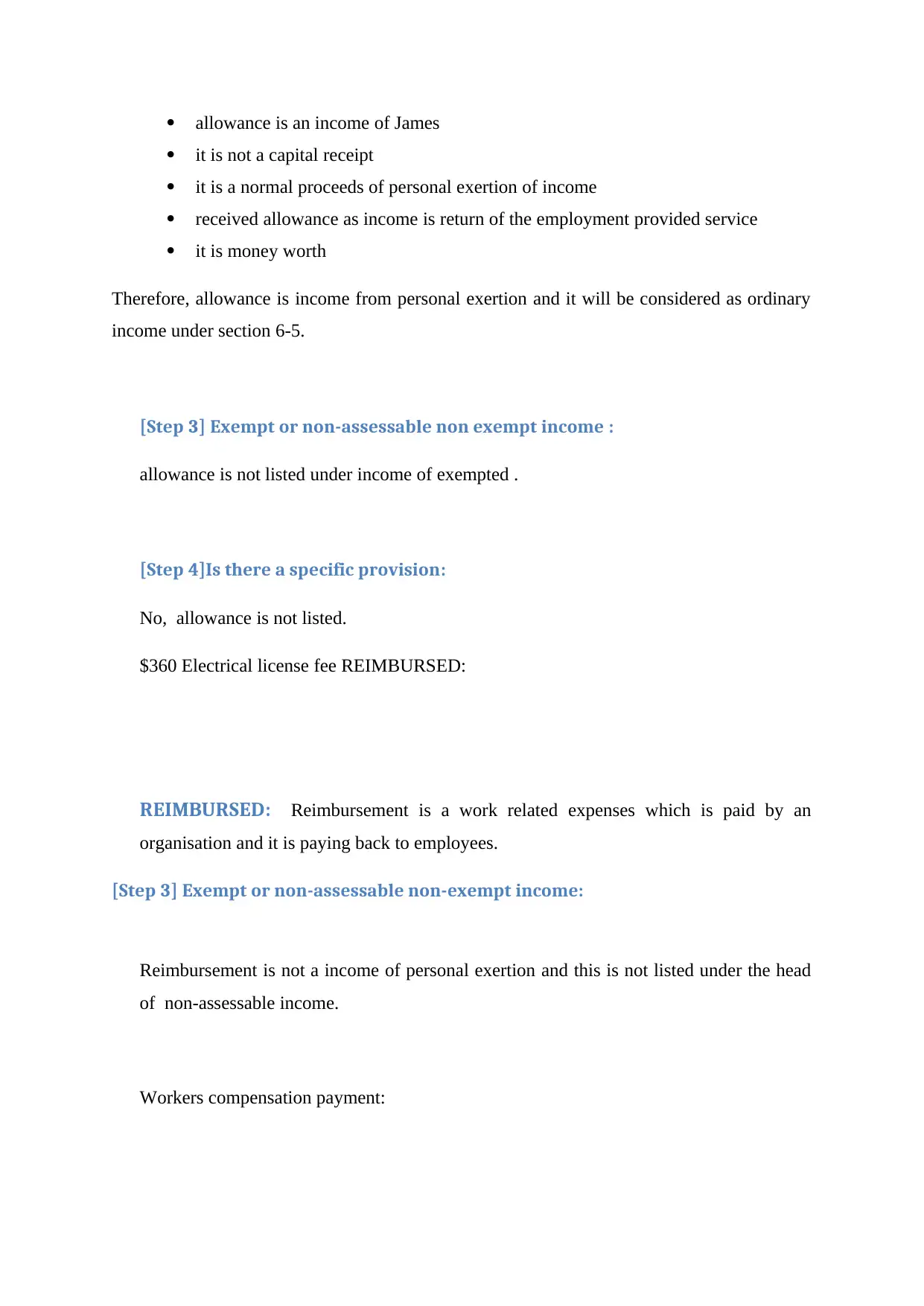
allowance is an income of James
it is not a capital receipt
it is a normal proceeds of personal exertion of income
received allowance as income is return of the employment provided service
it is money worth
Therefore, allowance is income from personal exertion and it will be considered as ordinary
income under section 6-5.
[Step 3] Exempt or non-assessable non exempt income :
allowance is not listed under income of exempted .
[Step 4]Is there a specific provision:
No, allowance is not listed.
$360 Electrical license fee REIMBURSED:
REIMBURSED: Reimbursement is a work related expenses which is paid by an
organisation and it is paying back to employees.
[Step 3] Exempt or non-assessable non-exempt income:
Reimbursement is not a income of personal exertion and this is not listed under the head
of non-assessable income.
Workers compensation payment:
it is not a capital receipt
it is a normal proceeds of personal exertion of income
received allowance as income is return of the employment provided service
it is money worth
Therefore, allowance is income from personal exertion and it will be considered as ordinary
income under section 6-5.
[Step 3] Exempt or non-assessable non exempt income :
allowance is not listed under income of exempted .
[Step 4]Is there a specific provision:
No, allowance is not listed.
$360 Electrical license fee REIMBURSED:
REIMBURSED: Reimbursement is a work related expenses which is paid by an
organisation and it is paying back to employees.
[Step 3] Exempt or non-assessable non-exempt income:
Reimbursement is not a income of personal exertion and this is not listed under the head
of non-assessable income.
Workers compensation payment:
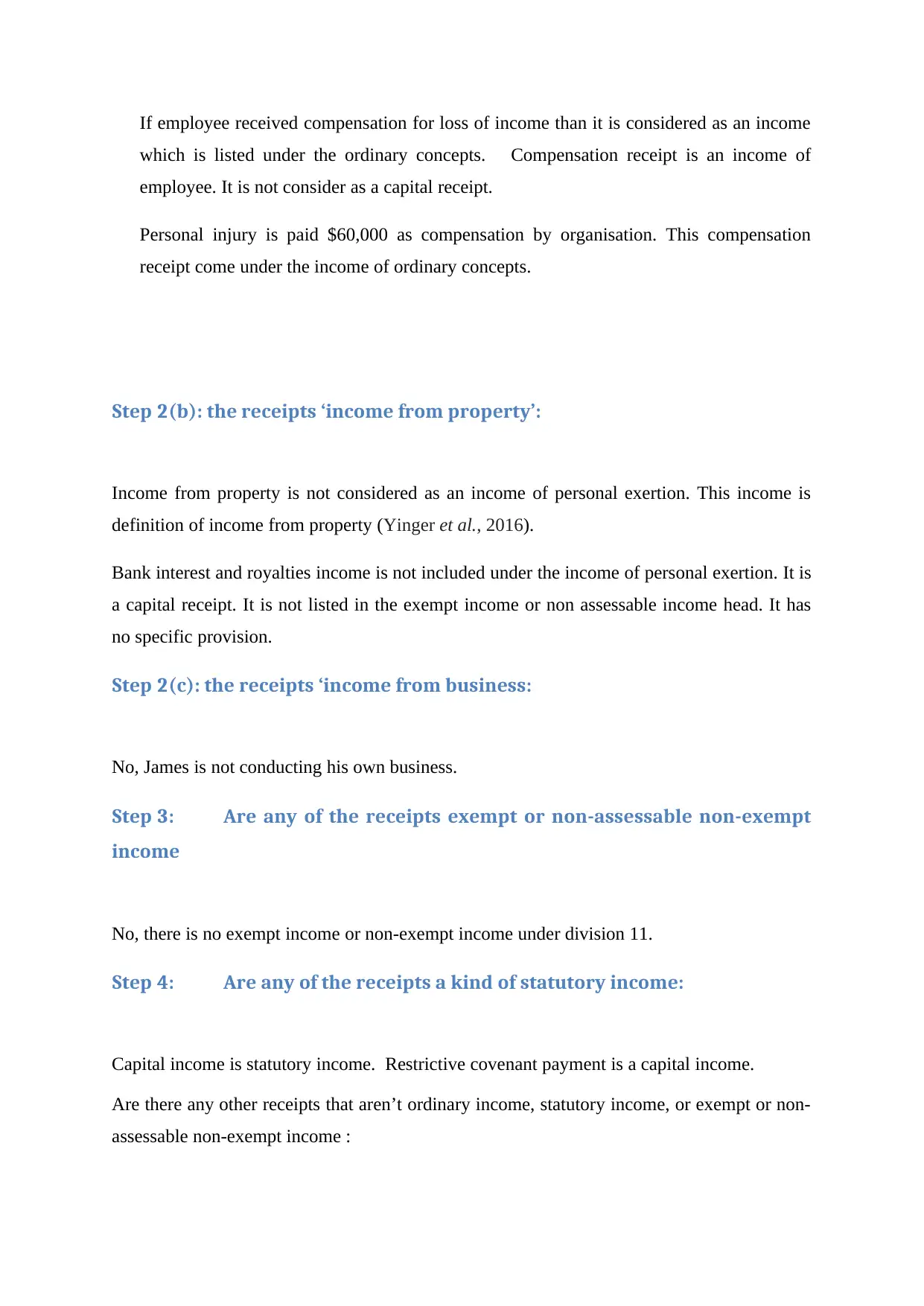
If employee received compensation for loss of income than it is considered as an income
which is listed under the ordinary concepts. Compensation receipt is an income of
employee. It is not consider as a capital receipt.
Personal injury is paid $60,000 as compensation by organisation. This compensation
receipt come under the income of ordinary concepts.
Step 2(b): the receipts ‘income from property’:
Income from property is not considered as an income of personal exertion. This income is
definition of income from property (Yinger et al., 2016).
Bank interest and royalties income is not included under the income of personal exertion. It is
a capital receipt. It is not listed in the exempt income or non assessable income head. It has
no specific provision.
Step 2(c): the receipts ‘income from business:
No, James is not conducting his own business.
Step 3: Are any of the receipts exempt or non-assessable non-exempt
income
No, there is no exempt income or non-exempt income under division 11.
Step 4: Are any of the receipts a kind of statutory income:
Capital income is statutory income. Restrictive covenant payment is a capital income.
Are there any other receipts that aren’t ordinary income, statutory income, or exempt or non-
assessable non-exempt income :
which is listed under the ordinary concepts. Compensation receipt is an income of
employee. It is not consider as a capital receipt.
Personal injury is paid $60,000 as compensation by organisation. This compensation
receipt come under the income of ordinary concepts.
Step 2(b): the receipts ‘income from property’:
Income from property is not considered as an income of personal exertion. This income is
definition of income from property (Yinger et al., 2016).
Bank interest and royalties income is not included under the income of personal exertion. It is
a capital receipt. It is not listed in the exempt income or non assessable income head. It has
no specific provision.
Step 2(c): the receipts ‘income from business:
No, James is not conducting his own business.
Step 3: Are any of the receipts exempt or non-assessable non-exempt
income
No, there is no exempt income or non-exempt income under division 11.
Step 4: Are any of the receipts a kind of statutory income:
Capital income is statutory income. Restrictive covenant payment is a capital income.
Are there any other receipts that aren’t ordinary income, statutory income, or exempt or non-
assessable non-exempt income :

Other receipts which is received / collected by James on the bus stop is not come under any
ordinary income, statutory income and exempt income or non-assessable non- exempt
income.
ordinary income, statutory income and exempt income or non-assessable non- exempt
income.
Secure Best Marks with AI Grader
Need help grading? Try our AI Grader for instant feedback on your assignments.
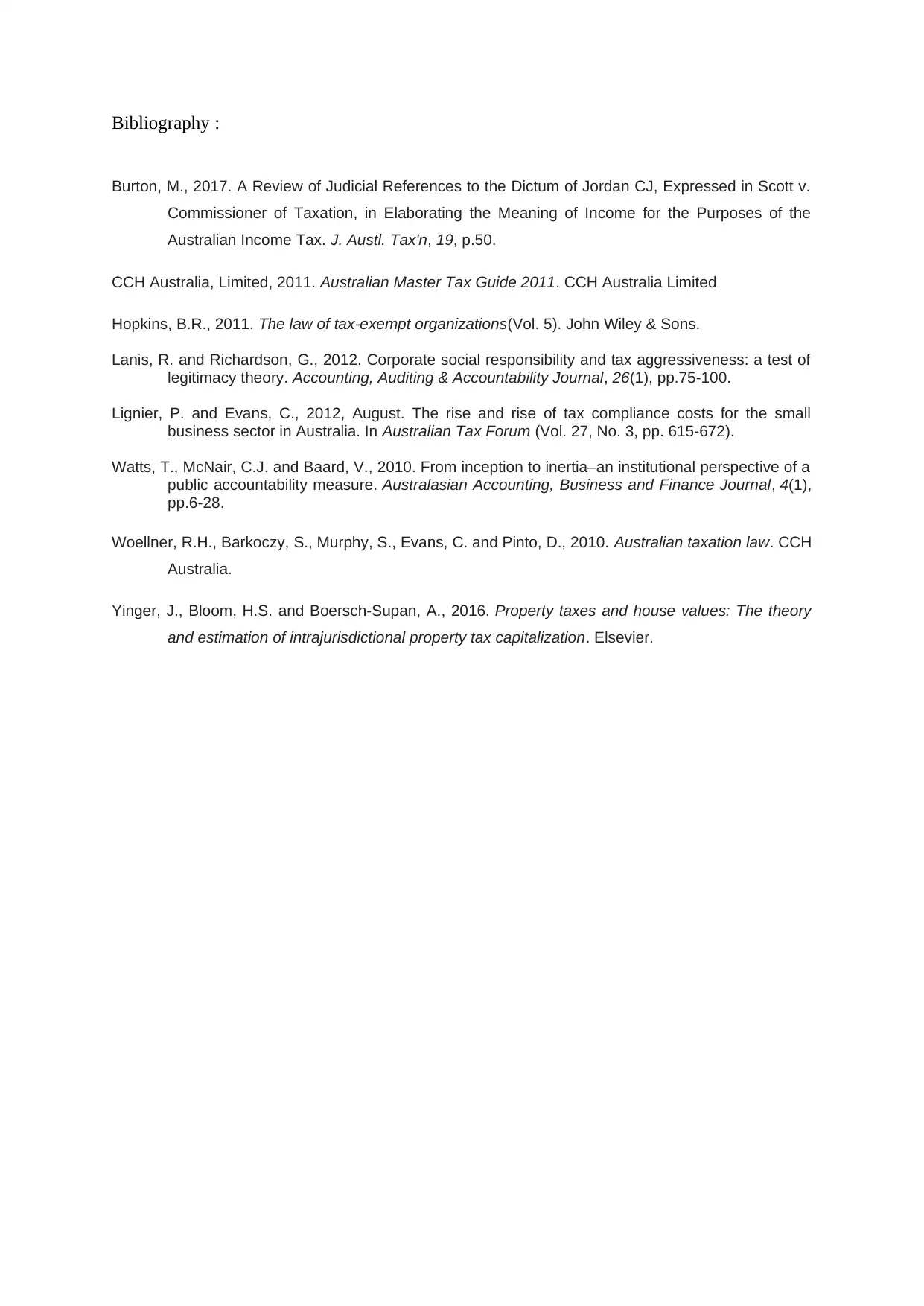
Bibliography :
Burton, M., 2017. A Review of Judicial References to the Dictum of Jordan CJ, Expressed in Scott v.
Commissioner of Taxation, in Elaborating the Meaning of Income for the Purposes of the
Australian Income Tax. J. Austl. Tax'n, 19, p.50.
CCH Australia, Limited, 2011. Australian Master Tax Guide 2011. CCH Australia Limited
Hopkins, B.R., 2011. The law of tax-exempt organizations(Vol. 5). John Wiley & Sons.
Lanis, R. and Richardson, G., 2012. Corporate social responsibility and tax aggressiveness: a test of
legitimacy theory. Accounting, Auditing & Accountability Journal, 26(1), pp.75-100.
Lignier, P. and Evans, C., 2012, August. The rise and rise of tax compliance costs for the small
business sector in Australia. In Australian Tax Forum (Vol. 27, No. 3, pp. 615-672).
Watts, T., McNair, C.J. and Baard, V., 2010. From inception to inertia–an institutional perspective of a
public accountability measure. Australasian Accounting, Business and Finance Journal, 4(1),
pp.6-28.
Woellner, R.H., Barkoczy, S., Murphy, S., Evans, C. and Pinto, D., 2010. Australian taxation law. CCH
Australia.
Yinger, J., Bloom, H.S. and Boersch-Supan, A., 2016. Property taxes and house values: The theory
and estimation of intrajurisdictional property tax capitalization. Elsevier.
Burton, M., 2017. A Review of Judicial References to the Dictum of Jordan CJ, Expressed in Scott v.
Commissioner of Taxation, in Elaborating the Meaning of Income for the Purposes of the
Australian Income Tax. J. Austl. Tax'n, 19, p.50.
CCH Australia, Limited, 2011. Australian Master Tax Guide 2011. CCH Australia Limited
Hopkins, B.R., 2011. The law of tax-exempt organizations(Vol. 5). John Wiley & Sons.
Lanis, R. and Richardson, G., 2012. Corporate social responsibility and tax aggressiveness: a test of
legitimacy theory. Accounting, Auditing & Accountability Journal, 26(1), pp.75-100.
Lignier, P. and Evans, C., 2012, August. The rise and rise of tax compliance costs for the small
business sector in Australia. In Australian Tax Forum (Vol. 27, No. 3, pp. 615-672).
Watts, T., McNair, C.J. and Baard, V., 2010. From inception to inertia–an institutional perspective of a
public accountability measure. Australasian Accounting, Business and Finance Journal, 4(1),
pp.6-28.
Woellner, R.H., Barkoczy, S., Murphy, S., Evans, C. and Pinto, D., 2010. Australian taxation law. CCH
Australia.
Yinger, J., Bloom, H.S. and Boersch-Supan, A., 2016. Property taxes and house values: The theory
and estimation of intrajurisdictional property tax capitalization. Elsevier.
1 out of 11
Your All-in-One AI-Powered Toolkit for Academic Success.
+13062052269
info@desklib.com
Available 24*7 on WhatsApp / Email
![[object Object]](/_next/static/media/star-bottom.7253800d.svg)
Unlock your academic potential
© 2024 | Zucol Services PVT LTD | All rights reserved.





